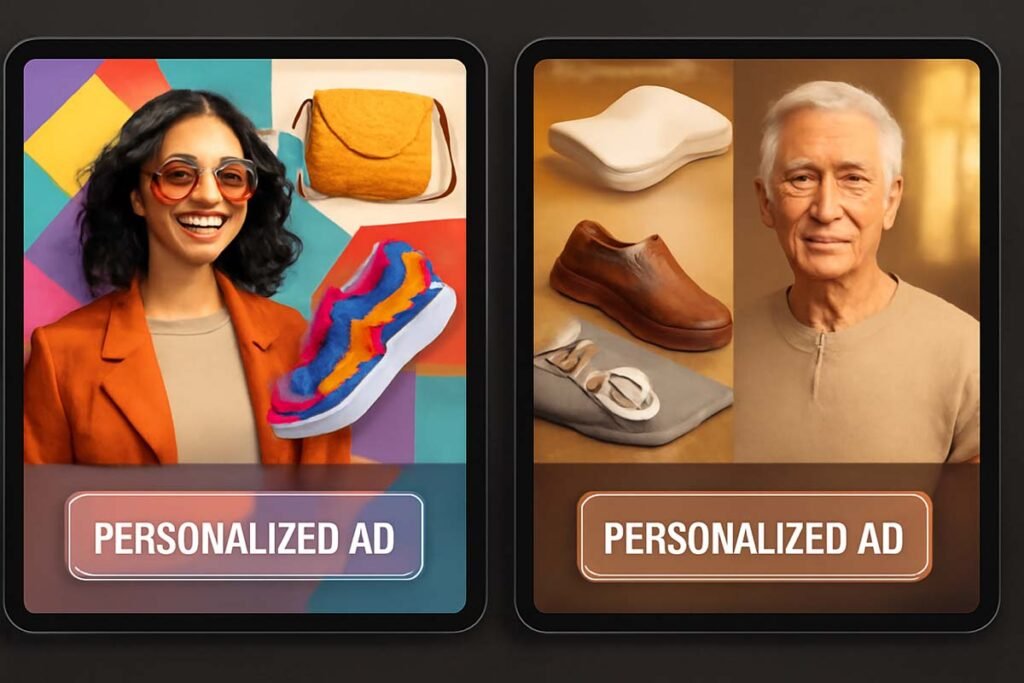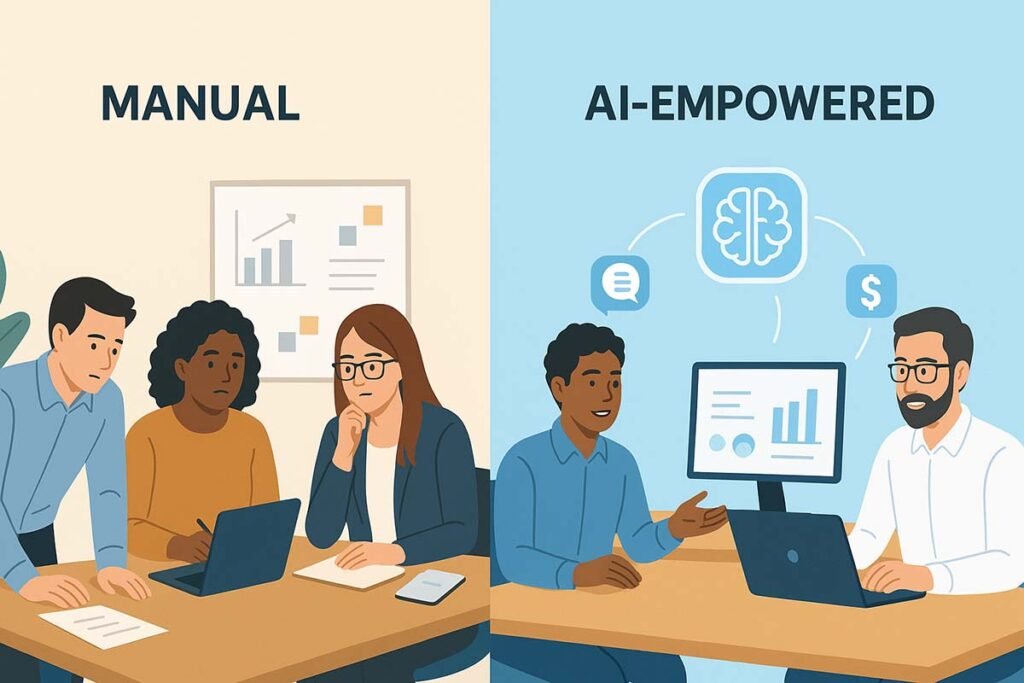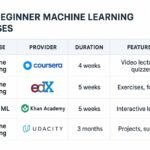AI for Digital Marketing: Digital marketing in 2025 is driven by one word: intelligence. As audiences scatter across dozens of platforms, attention spans shrink, and privacy rules shift, marketers need more than guesswork to thrive. Artificial intelligence (AI) has emerged as the secret sauce transforming how campaigns are planned, launched, refined, and scaled. The days of manual A/B testing, broad targeting, and static reports are over—AI brings real-time optimization, hyper-personalized messaging, and results that only get better with time.
But harnessing AI isn’t just for tech giants anymore. Today, agencies, startups, solopreneurs, and even local businesses can access the same campaign optimization firepower previously reserved for Fortune 500s—if they know where to start. In this deep-dive guide, you’ll discover how AI is redefining every step of digital marketing, which tools are leading the charge, and practical strategies to boost ROI and efficiency in 2025 and beyond.
Why AI Matters in Digital Marketing Today
AI isn’t a buzzword anymore. It’s a business imperative. Here’s why:
- Complexity: More channels, platforms, and data than ever before.
- Personalization Demanded: Audiences want hyper-relevant content, not generic ads.
- Speed: Marketing decisions need to be made in real time, 24/7.
- Efficiency: Budgets must stretch further, requiring automation and precision.
According to a 2025 Gartner survey, 80% of marketers say AI-driven campaigns outperform traditional efforts on engagement, ROI, and speed to market.
Top AI Tools Powering Campaign Optimization
AI for Ad Creation & Copywriting
- Jasper: Generates conversion-focused long and short-form ad copy (Google, Meta, LinkedIn).
- Copy.ai & Writesonic: Instantly create hundreds of headline, CTA, and product description variants.
- Persado: Uses emotion-driven AI to tailor language for maximum action.
- Canva Magic Write: AI-driven content and design suggestions to streamline ad creative.
AI for Audience Targeting
- Meta Advantage+ / Google Performance Max: Machine learning identifies hidden audience segments and optimizes ad delivery.
- Albert: Fully-automated multichannel campaign manager, learns and iterates across platforms.
- Clearbit & 6sense: Real-time intent and B2B lead enrichment, letting you reach the right decision-maker at the right moment.
AI for Analytics & Reporting
- Google Analytics 4 (GA4): Predicts conversion likelihood, churn risk, and surfaces key trends automatically.
- Supermetrics: AI-powered data blending for cross-platform campaign tracking.
AI for Personalization & Automation
- HubSpot & Salesforce Einstein: Personalizes web, email, and ad journeys at scale.
- Drift & Intercom: Chatbots and conversational AI for lead nurturing and sales.
Key Campaign Optimization Strategies with AI
Dynamic Creative Optimization (DCO)
AI automatically assembles and tailors ad combinations (headline, image, CTA) for each viewer, based on:
- Browsing behavior
- Demographics
- Real-time engagement
Example:
A clothing retailer uses DCO on Meta. Customers in cold regions see winter wear, while those in tropical areas get summer styles. The system tests unlimited combinations to maximize clicks.
Predictive Audience Segmentation
AI groups users by propensity to convert, then spends more on those likely to buy. Inputs can include:
- Past purchases
- Website behavior
- Email engagement
- Social activity
Table: Traditional Targeting vs. AI Predictive Targeting
| Approach | Data Used | Segmentation granularity | Conversion Rate |
|---|---|---|---|
| Traditional | Age, gender, region | Broad | 1.2% |
| AI Predictive | 50+ signals, intent | Micro-segments | 4.8% |
Automated Bidding & Budget Allocation
Platforms like Google and Meta now use AI to:
- Predict which impressions will yield conversions.
- Automatically adjust bids to win those auctions.
- Shift spend to highest-performing audiences and times of day.
This saves time and vastly improves efficiency.

Multichannel Orchestration
AI tracks a user across:
- Search ads
- Social ads
- Website personalization
…and ensures the right message is delivered at the right touchpoint, at the right time—no more siloed campaigns.
Real-Life Examples & Case Studies
Case Study 1: SaaS Startup Grows with Predictive Targeting
A B2B SaaS in California leveraged Albert AI to find their “lookalike” highest-value customers. Result? 60% lower cost-per-click on LinkedIn and 3x return from Facebook retargeting.
Case Study 2: E-Commerce DCO Boosts Sales
A UK fashion brand running Google’s Performance Max saw a 35% increase in ROAS (return on ad spend) after switching to AI-driven DCO—ads adapted in real time as shopper intent and trends shifted.
Case Study 3: Local Restaurant Thrives on Small Budget
Using Copy.ai for ad copy and automated targeting on Meta, a local pizza shop reduced campaign creation time by 70% and doubled online orders, despite spending less than $300/month.
Pros, Cons, and Potential Pitfalls
Pros
- Unmatched speed and scale
- Never stop optimizing (24/7 learning)
- Hyper-personalization
- Objective, data-driven decisions
Cons
- “Black box” decisions—AI may not always explain why
- Need for large, clean data sets
- Tools can be pricey or require learning curve
- Risk of over-automation (losing brand voice or creativity)
Common Pitfalls:
- Relying 100% on automation (ignore gut + human creativity)
- Not monitoring regularly (AI can run off track with poor data)
- Failing to align AI goals with business strategy
Expert Insights: What Top Marketers Say
“AI multiplies the effectiveness of creative teams by removing grunt work and uncovering audience insights you’d never find manually.”
— Marie Faulkner, Global Head of Digital, SpinTech Group
“The best marketers in 2025 are AI-literate. They guide the algorithm rather than just following it.”
— Ajay Malhotra, Performance Marketing Consultant
“Data and empathy must go hand in hand—AI gives you the why, but humans give you the what and how.”
— Lisa Chen, CMO, Local Eats International
Getting Started: Action Plan for 2025
- Audit Your Current Stack: Is any part of your ad or campaign workflow still manual or generic?
- Research and Pilot AI Tools: Start with free trials of ad copy generators, analytics, or DCO tools.
- Gather and Clean Data: The better your inputs, the smarter the AI.
- Set Clear Goals: Align AI with metrics—leads, sales, ROAS, engagement.
- Train Your Team: Ensure staff are empowered to interpret AI reports and intervene when needed.
- Test and Iterate: Start with one campaign, analyze results, scale what works.
Checklist Table:
| Step | Task Example | Resource Suggestion |
|---|---|---|
| Audit | Identify manual campaign steps | Google Analytics 4 |
| Pilot | Test Copy.ai for Facebook Ad Copy | Copy.ai, Writesonic |
| Data Prep | Clean up CRM and website tracking | HubSpot, Segment |
| Goal Setting | Define “success” (ROI, signups, etc.) | Google Data Studio |
| Training | Share tutorials with team | HubSpot Academy |
| Test & Iterate | AB test AI-generated vs. human copy | Meta, Google Ads |
The Real Secret to AI-Powered Marketing
AI for digital marketing is not about replacing marketers—it’s about amplifying their superpowers. The brands and agencies that win in 2025 will combine AI’s speed, scalability, and intelligence with human creativity, empathy, and critical thinking.
Embrace experimentation. Start small, measure often, and never lose sight of the customer’s real needs. Whether you’re a solo founder, specialist, or marketing director, learning to partner with AI will be your most valuable skill. Ready to optimize your next campaign? Dive in, test an AI tool, and watch your results soar!
FAQ: AI in Digital Marketing
Q1. Will AI replace human marketers?
A1: No—AI handles analysis and optimization, but strategy, storytelling, and creative decisions need humans.
Q2. Are there affordable AI tools for small businesses?
A2: Yes—Copy.ai, Writesonic, and Canva Magic Write all offer affordable plans and free tiers.
Q3. Can AI improve my SEO rankings?
A3: AI-driven keyword research, content optimization, and predictive analytics help boost SEO performance.
Q4. Is it safe to use AI for handling my customer data?
A4: Leading AI tools comply with strict privacy standards, but always review data policies before implementing.
Q5. How do I measure AI’s impact on my campaigns?
A5: Use built-in analytics and set clear KPIs for conversion, ROAS, and engagement. Compare with previous manual campaigns.
Q6. What’s the main risk of using too much automation?
A6: Losing your unique brand voice and missing out on creative, human-driven ideas. Always blend AI with a personal touch.
Q7. Which campaign types benefit most from AI?
A7: Paid ads, email campaigns, content writing, and lead nurturing all see fast improvement with AI tools.
Q8. Can I use AI across different platforms at once?
A8: Yes! Tools like Albert, Performance Max, and HubSpot allow for omnichannel orchestration.




Pingback: AI-Powered Productivity Tools for Remote Workers & Freelancers in 2025 - FirstsPost
Pingback: How AI Improves Mental Health: Apps, Therapy Bots & Wellness Tools in 2025 - FirstsPost
Pingback: How AI Revolutionizing Healthcare in the USA: 2025 Trends & Essential Patient Tools - FirstsPost
Pingback: Top AI Writing & Content Creation Tools for US Marketers in 2025 - FirstsPost
Pingback: Latest AI News & Breakthroughs You Shouldn’t Miss (Monthly Roundup – August 2025) - FirstsPost